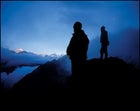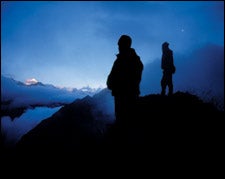 Climbers in the Peruvian Andes
Climbers in the Peruvian Andes
“WE SHALL VISIT THE MOON now before very long, probably within the next thousand years,” Apsley Cherry-Garrard, one of polar explorer Robert Falcon Scott’s men, prophesied shortly after slogging up Antarctica’s Beardmore Glacier in 1911.
This wild miscalculation by the author of The Worst Journey in the World indicates what a long way we’ve traveled in just 91 years. By 1977, when you may have plunked down $2.50 for an early issue of this magazine, many of the most famous physical challenges on the planet had been knocked off. We’d ventured to the loftiest point (Mount Everest, 1953) and come near the lowest (the Mariana Trench, 1960). Not to mention the wettest, driest, hottest, and coldest stretches of each continent. Every backwater on the globe lay within striking distance of a 747; even the moon had been requisitioned as a golf course.
���ϳԹ��� still managed to find a few things to write about, of course, because something subtle but significant had happened along the way: The very nature of adventure changed. Once the domain of state-sanctioned professionals who pursued the unknown in the name of fame, science, or the glory of nations, exploration was reinvented as a more personal journey, available to almost everyone. These days, meaningful discoveries are within reach of anyone with a little initiative and a few days off work. Armed with better gear, new insights into health and the physiology of endurance, and a growing respect for the value of fragile cultures and environments, increasing numbers of us have been booking flights into the unfamiliar, just to see what’s there.
Call it the Age of the Inspired Self-Starter—and know that in the next 25 years, there’s still room for plenty of creative rambling. On the most literal level, the notion that we’re running out of terra incognita is plainly wrong. Take Nepal. While countless crampon teeth have dimpled the trail up Kanchenjunga, last December the kingdom opened up 103 previously unbagged peaks to climbers. That list is now down to 102—in May, Americans Peter Ackroyd and Jim Frush topped out on 20,270-foot Gaugiri and returned with glowing reports of a virgin Himalayan playground. “We saw many excellent peaks that will take you into places that no one has explored,” they told excited members of the American Alpine Club. Similarly, untold thousands of square miles of little-traveled terrain awaits the self-sufficient all around the world—even in the hidden corners of the United States.
But adventure is not just about remote firsts; it’s also a matter of individual spirit and style. Indeed, a fine role model for the next 25 years is someone like 35-year-old Swedish globe-trotter Göran Kropp, who in 1996 rode his bike, solo and unsupported, from Stockholm to Nepal, bagged the summit of Everest without oxygen, and then pedaled home. (He’s now planning a single-handed sailing trip to Antarctica.)
“The true adventurer,” British alpinist Christian Bonington reminds us, “is one who escapes the treadmill of the obvious.” In that spirit, I recently scrapped the logistical burdens and fleeting thrills of a planned trip to the North Pole. Instead I’m taking my new baby trekking with the Sami people in Lapland.
By 2102, when ���ϳԹ��� celebrates its 125th birthday, we probably will have put human explorers on Mars. We’ll eventually launch intergalactic getaways from orbiting base camps. Thanks to increasingly sophisticated satellite imagery, we’ll have mapped vast valleys on the ocean floors and descended into thousands of miles of hitherto undetected labyrinths. The deep, along with conscientiously preserved expanses of African jungle and South American rainforest, will have yielded astounding medical breakthroughs, and we’ll have figured out how to share news of our epic feats—live and static-free—from anywhere on earth, at sea, or in space.
Or maybe it will all happen faster than that. The truth is, I don’t know exactly what lies ahead, or how quickly we can get there. Nobody does. But I know this: Men and women will always go adventuring. The impulse to explore is fundamental to the human condition. Motives differ—a thirst for knowledge, a desire to slip the shackles of the mundane, a fascination for the heady thrills of the unknown. Cherry-Garrard may have been wrong about the moon, but he was right about something. The whole glorious, unending story of adventure, he concluded, “is about human minds with all kinds of ideas and questions involved, which stretch beyond the furthest horizons.”

